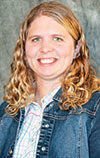In the land of 10,000 lakes, Rock County is one of two counties in the state without one.
“It’s a little bit smaller than some. It’s not the smallest. We’re probably average to lower as far as land,” says Doug Bos, assistant director of Rock County Soil and Water Conservation District/Land Management.
Bos estimates feedlots with more than 1,000 animal units are about 15 percent of the total in the county, 25 to 30 percent are in the less-than-300 range, and the majority are between 300 and 999 head.
Bos’ office has helped feedlot operators obtain state and federal cost-share dollars for fixing any runoff problems they may have. They also help them in working with the Minnesota Pollution Control Agency, the state’s permitting agency.
“During expansions, we help them to expand in an environmentally friendly process and help them through the steps of permitting,” Bos says. “We’re the liaison between the farmer and the MPCA. We help them with the permitting process, with going through nutrient management planning process, and then walk them through it.”
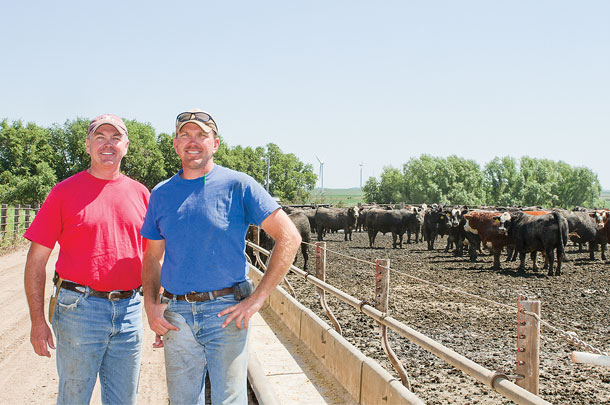
Brothers Peter and Jay Bakken of BLAC-X Farms near Beaver Creek, Minnesota, are one of those feedlots that worked with Bos to get their feedlot permitted.
The Bakkens’ grandfather started as a dairyman and dairied until the mid-1970s. At that time, their father got started in the cattle-feeding business. After Peter graduated from South Dakota State University in 1990, he returned to the farm and is in charge of the cow-calf herd.
Jay graduated from SDSU in 1999 and came home and took over feedlot management. They also grow corn and soybeans on their operation.
In 1994, their dad started the process to correct a runoff issue. At the time, few producers were taking steps to make their operations more environmentally friendly. Jay says at the time it was frustrating, but they did end up with a containment berm around the first yards and then filtered the runoff.
“When we initially started, I would say Dad was one of the initial people that started asking questions when it looked like we were going to have environmental concerns in Minnesota,” Peter says. “Now Minnesota, in hindsight, was really forward-thinking in their developing a whole system of permitting and environmental control.”
When Jay came home, they were feeding 800 to 1,000 head. They added more pens in 2006, which doubled their capacity. They are permitted for 3,000 head. However, with the additional pen they added this summer, they will be at 2,500.
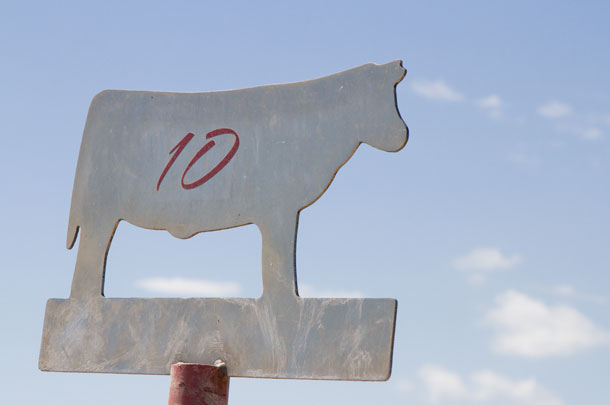
Pen sizes vary from 110 head up to 300.
“We used to do quite a bit of custom feeding, and that is why we had many different pen sizes for different groups and ownership,” Jay says. “We primarily own everything now. Now, it’s just dividing group sizes into the different pens however they fit best.”
Since their feedlot is permitted for more than 1,000 animal units, they catch all of the effluent and contain it in a brown-water basin. In the summer, they use a traveling gun to irrigate fields south of the open lots. They haul out the solids in a dry-box spreader.
Since they are farmer-feeders, like most other feedlot operators in southwest Minnesota, all of the corn they grow gets fed in the feedlot.
“To me, a livestock operation is really pretty sustainable. You use the manure you produce to raise the crop that you feed the animal. It’s just a big circle,” Peter says.
Jay prefers to feed cattle in open lots. Their location in Rock County has rolling hills and some slope, which is not typical for southwestern Minnesota.
“I’ve always say there’s really only two things you need to feed cattle – space and drainage,” Jay says.
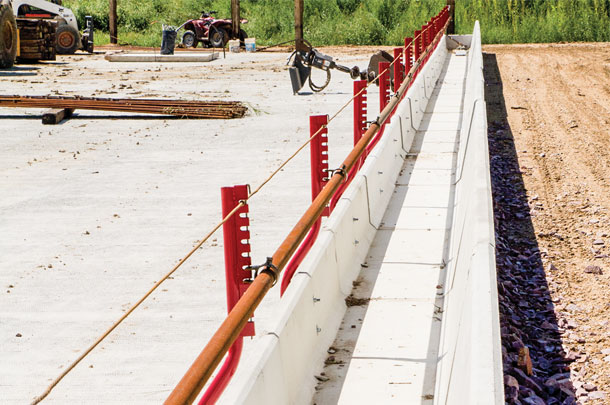
Feeders either have the space and drainage naturally or they have to build for the space and drainage. Jay says the sandy clay soil is the right kind of soil, and the right topography makes for good feeding in open lots.
On the other hand, he admits that the lots get muddy, and it gets cold and snowy during the winter. Some may prefer a structure to feed in, but Jay feels comfortable feeding in open lots.
“We know how to manage these yards, between bedding and cleaning and snow removal and all that stuff, versus spending the money on a structure. That’s why we went the route that we did,” Jay says. “I haven’t seen any better or worse cattle performance in a building than out here, so my cost per animal unit to build this facility is considerably cheaper than anything else we could do down here.”
About 10 years ago, the push was to build monoslope barns. Today, the popular facility for the area is the slat barn. In the slat barn, the floor is slatted and the manure is gathered in a pit below the barn. The draw to these types of barns is the limited manure hauling and the small amount of space needed per animal unit.
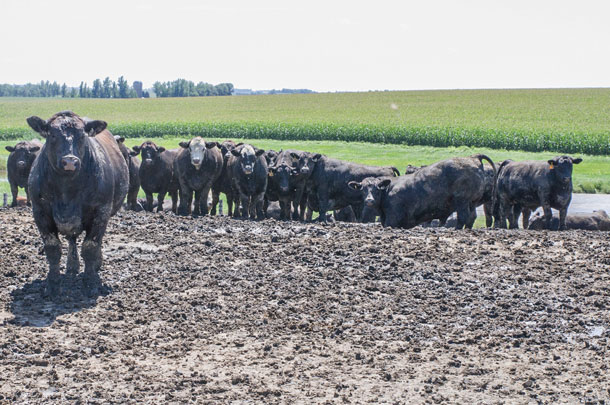
Jay says he is probably running 250 square feet per head and cattle in a slat barn at about 25 square feet per head. With high land values, building a slat barn is an attractive option for producers who do not have ideal land for open lots. They are also easy to permit because all of the manure is contained below the barn.
“People that didn’t have the topography to do that went with a monoslope barn. Everything’s about a trade. Either you spend the money on a building or you spend money on the land, and then you have to manage what you have to manage,” Peter says.
Jay says feeders have been expanding in Rock County, particularly in the last eight years. Some have a child coming back into the operation. High-priced ag land makes feeding cattle or raising livestock a good option to bring on another family.
The Bakkens get most of their cattle from producers in the Dakotas and Montana. Some feeders in their area feed out dairy steers from the dairies in the region.
The Bakkens think there are many feedlots in their area of Minnesota because of the availability of feed, their proximity to ethanol byproducts and the closeness of packing facilities. With five ethanol plants within an hour of their place, mixing distillers grains into the ration has helped cheapen their feed costs.
Minnesota State Cattlemen’s Association executive director Ashley Kohls agrees that easy availability of feed sources makes southwest Minnesota a good place to feed cattle.
“We have progressive feeders all across the state, but the largest portion is in the southwest corner. The biggest draw, I think, to them being in the southwest corner is the feed sources. They have the ability to grow significant amounts of feed there that we don’t necessarily get in the upper half of the state,” Kohls says.
The USDA National Agricultural Statistics Service’s August Cattle on Feed report showed 133,000 head for feedlots with capacity greater than 1,000 head. That is up 16 percent from 2014.
The Minnesota Department of Agriculture works to promote livestock growth through its agricultural marketing and development division. Jim Ostlie, livestock development and planning specialist, says they offer a variety of programs to promote feedlot growth in the state.
“First and foremost is our livestock development team, which offers free non-regulatory consultations in the fields of permitting, environmental compliance, feedlot siting, nutrient management, nutrition, grazing and more,” Ostlie says. “We also coordinate the Minnesota Farm Link Program that assists farmers to find opportunities to transition to the next generation or even just find a place to farm.”
Ostlie says the state supports livestock development by offering $2 million in livestock investment grants annually. Producers can apply for grants that would pay up to 10 percent of the project’s cost. The minimum amount of money they would award is $400 and a maximum of $50,000.
“Minnesota’s a great place to raise cattle because of the local availability of feedstuffs, as well as our water availability, our access to markets, veterinary services, research, consulting firms and the access to top-rated university research through the University of Minnesota and their veterinary medicine school,” Ostlie says.
The Bakkens say people in their area have been favorable to livestock operations.
“It’s favorable. It’s a good time in this area for livestock because, for the most part, it’s accepted by neighbors and the neighborhoods that we live in,” Jay says.
“People understand it now. You’re always fearful of something you don’t understand,” Peter says. ![]()
Wendy Sweeter is a freelance writer based in South Dakota.
PHOTO 1: Peter and Jay Bakken feed about 2,500 head of cattle in open lots at their feedlot near Beaver Creek, Minnesota.
PHOTO 2: pen marker
PHOTO 3: The Bakkens put in a new pen in August.
PHOTO 4: The Bakkens use the effluent that comes off their lots to irrigate corn growing behind the lots. Photos courtesy of Wendy Sweeter.
